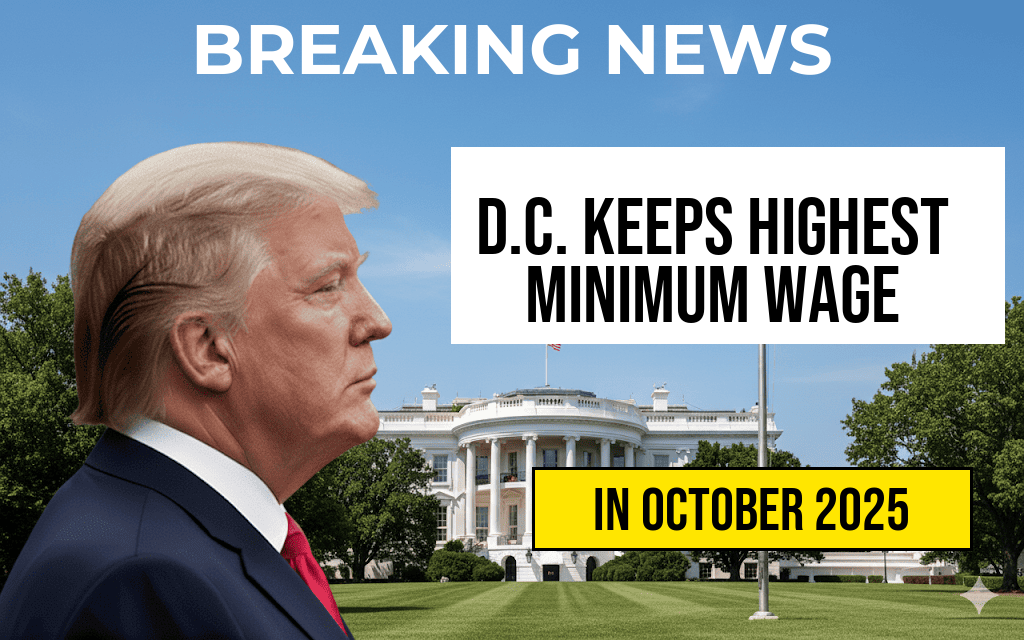Washington D.C. continues to set the national standard for wage policies, maintaining its position as the U.S. city with the highest minimum wage at $17.95 per hour. The District’s commitment to a living wage reflects ongoing efforts to address income disparities and improve economic stability for workers in the nation’s capital. This figure, which took effect at the start of 2024, surpasses minimum wages in other major cities and states, positioning D.C. as a leader in minimum wage legislation. The city’s approach is rooted in recent legislative adjustments and wage indexing mechanisms designed to keep pace with inflation and cost of living increases. As policymakers and advocacy groups monitor the impact, debates continue over the broader implications for businesses, employment levels, and economic equity across the region.
Historical Context and Legislative Framework
The current minimum wage in Washington D.C. has seen steady growth over the past decade, driven by legislative actions aimed at reducing income inequality. In 2016, D.C. enacted a phased increase to reach the current rate, with scheduled hikes aligned to inflation projections. The District’s approach is characterized by a combination of mandatory annual increases and indexing provisions, ensuring wages remain responsive to economic changes.
Comparison with Other U.S. Cities and States
| Location | Minimum Wage | Effective Date |
|---|---|---|
| Washington D.C. | $17.95 | January 2024 |
| Seattle, WA | $18.43 | January 2024 |
| San Francisco, CA | $16.99 | January 2024 |
| New York City, NY | $15.00 | December 2023 |
| Texas (Statewide) | $7.25 (federal minimum) | Established in 2009 |
While some cities like Seattle have edged past D.C. with slightly higher wages, the District’s rate remains the highest among major urban centers. States such as California and New York have also adopted high minimum wages, but D.C.’s status as a federal district with a unique legislative framework gives it a distinctive position in setting wage standards.
Economic Impact and Community Response
Economic analysts observe that D.C.’s high minimum wage aims to bolster purchasing power among lower-income workers, many of whom are employed in service, hospitality, and retail sectors. However, some business leaders have expressed concerns about increased labor costs potentially affecting employment rates and small business viability.
According to recent studies from the Economic Policy Institute, wage increases in urban centers can lead to enhanced worker productivity and reduced turnover. Conversely, critics argue that overly aggressive minimum wage hikes may lead to reduced hiring or increased automation. The D.C. government continues to monitor these dynamics closely, emphasizing support programs for displaced workers and small businesses.
Policy Drivers and Future Outlook
Advocacy groups have long championed D.C.’s high minimum wage as a model for equitable economic policy nationwide. The city’s legislation is influenced by a broader movement to address income inequality and improve quality of life for its residents. Mayor Muriel Bowser’s administration has reiterated its commitment to maintaining the highest minimum wage in the country, with plans to review and adjust rates periodically based on economic conditions.
Looking ahead, policymakers are considering additional measures such as targeted tax credits and workforce development initiatives to complement wage policies. As economic conditions evolve, the District’s approach to balancing fair wages with sustainable business growth remains a focal point for regional economic planning.
Broader Implications and Ongoing Debates
Washington D.C.’s leadership on minimum wage issues influences nationwide discussions about fair pay and economic justice. Elected officials, labor unions, and business associations continue to debate the optimal balance between supporting workers and maintaining a competitive business environment. The city’s experience provides valuable insights for other jurisdictions contemplating significant wage hikes amid varying economic landscapes.
For more on the history of minimum wage policies in the United States, visit Wikipedia’s Minimum Wage page. To explore recent economic analyses, consult reports from Forbes.
Frequently Asked Questions
What is the current minimum wage in Washington D.C.?
The current minimum wage in Washington D.C. is set at $17.95 per hour, making it the highest in the nation.
How does Washington D.C.’s minimum wage compare to other states?
Washington D.C.’s minimum wage of $17.95 per hour surpasses other states, maintaining its position as the leader with the highest minimum wage nationwide.
Are there any plans to increase the minimum wage further?
While the article does not specify future increases, Washington D.C. regularly reviews and adjusts its minimum wage to reflect economic conditions and cost of living.
Who is affected by the Washington D.C. minimum wage policy?
Workers earning wages in Washington D.C., particularly those in low-income jobs, are directly impacted by the minimum wage policy, ensuring fair compensation for their work.
What benefits does a higher minimum wage bring to Washington D.C.?
A higher minimum wage helps improve the standard of living for workers, reduces income inequality, and stimulates local economic growth in Washington D.C.

Leave a Reply